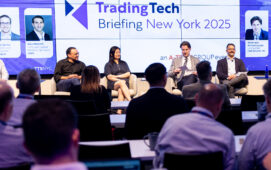Capitalising on Microsoft’s augmented reality HoloLens product, which was first made available to technology developers in March 2016, FlexTrade Systems, a trade execution and order management systems provider, has developed augmented reality trading capability for HoloLens, according to Andy Mahoney, business development director at FlexTrade UK.
HoloLens is an altered version of a virtual reality headset that looks more like a pair of large eyeglasses, leaving the user’s peripheral vision open. The glasses show the user holograms in space without blocking out their vision of the real world around them.
FlexAR lets users access the FlexTrader EMS trade execution management system through an interface designed for the Microsoft HoloLens.
“As you look around the room, you will see a FlexTrade trading blotter,” says Mahoney. “You can then say a series of keywords — like ‘create blotter,’ ‘create charts’ and ‘create pods.’ From there, about a meter away from you, those functions appear when selected. You get the blotter chart or pod. You can then interact with those pods in free space, pick them up and put them in different parts of the room, so you can have FX trading areas, equities trading areas and more.”
The “pods” Mahoney describes are a “horseshoe shape” around the user that would show all the various equities, currencies or other securities potentially being traded. With FlexAR, the user’s eye movement can focus on specific items in the pod and then select those items and interact with them to get prices, initiate trades or perform other functions.
FlexAR also provides three-dimensional graphing capability, according to Mahoney. “You can create a bubble chart that shows on the X axis the percentage of orders done on your blotter; on the Y axis, the P&L versus the arrival price; and on the Z axis, the percentage of average daily volume,” he says. “That way you see all the big orders very close, all the difficult orders very close, and the easy orders further away. You can then visualise it a lot more intuitively. You can encapsulate more data than you could on a normal two-dimensional graph. We tried this with a lot of traders and the feedback has been immense. They’ve been very excited by it.”
Subscribe to our newsletter




